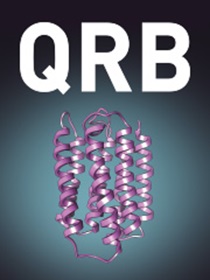单粒子电子低温显微镜:趋势、问题及未来展望
IF 7.2
2区 生物学
Q1 BIOPHYSICS
引用次数: 146
摘要
在过去的几年里,单粒子电子冷冻显微镜(cryoEM)在三维生物结构的测定方面取得了巨大的进展,使得从比以前要求的更少的图像中获得更高分辨率的地图。这主要是由于引入了一种新型的直接电子探测器,其探测量子效率比以前高2到3倍,并且改进了图像处理的计算算法。尽管已经取得了很大的进步,定量分析表明,如果能够解决与图像退化相关的问题,可能通过最小化成像过程中光束引起的样品运动和电荷积累,仍然有重大的进展要做。如果能实现这一点,就有可能获得更小的单个粒子的接近原子分辨率的结构,使用更少的图像和解析比目前更多的构象状态,从而实现该方法的全部潜力。最近,冷冻电镜在分子结构测定中的普及也凸显了对低成本显微镜的需求,因此我们鼓励开发一种廉价的100 keV电子冷冻显微镜,并配备高亮度场发射枪,使无法负担最先进300 keV设备的投资和运行成本的个人团体或机构可以使用该方法。通过低温电镜成功确定高分辨率结构的关键条件包括图像解释和优化生物化学和网格制备,以获得分布良好的感兴趣的大分子。因此,我们在这篇综述中包括了一个低温电镜照片画廊,展示了大型和小型大分子复合物的单粒子图像的说明性例子。本文章由计算机程序翻译,如有差异,请以英文原文为准。
Single particle electron cryomicroscopy: trends, issues and future perspective
Abstract There has been enormous progress during the last few years in the determination of three-dimensional biological structures by single particle electron cryomicroscopy (cryoEM), allowing maps to be obtained with higher resolution and from fewer images than required previously. This is due principally to the introduction of a new type of direct electron detector that has 2- to 3-fold higher detective quantum efficiency than available previously, and to the improvement of the computational algorithms for image processing. In spite of the great strides that have been made, quantitative analysis shows that there are still significant gains to be made provided that the problems associated with image degradation can be solved, possibly by minimising beam-induced specimen movement and charge build up during imaging. If this can be achieved, it should be possible to obtain near atomic resolution structures of smaller single particles, using fewer images and resolving more conformational states than at present, thus realising the full potential of the method. The recent popularity of cryoEM for molecular structure determination also highlights the need for lower cost microscopes, so we encourage development of an inexpensive, 100 keV electron cryomicroscope with a high-brightness field emission gun to make the method accessible to individual groups or institutions that cannot afford the investment and running costs of a state-of-the-art 300 keV installation. A key requisite for successful high-resolution structure determination by cryoEM includes interpretation of images and optimising the biochemistry and grid preparation to obtain nicely distributed macromolecules of interest. We thus include in this review a gallery of cryoEM micrographs that shows illustrative examples of single particle images of large and small macromolecular complexes.
求助全文
通过发布文献求助,成功后即可免费获取论文全文。
去求助
来源期刊

Quarterly Reviews of Biophysics
生物-生物物理
CiteScore
12.90
自引率
1.60%
发文量
16
期刊介绍:
Quarterly Reviews of Biophysics covers the field of experimental and computational biophysics. Experimental biophysics span across different physics-based measurements such as optical microscopy, super-resolution imaging, electron microscopy, X-ray and neutron diffraction, spectroscopy, calorimetry, thermodynamics and their integrated uses. Computational biophysics includes theory, simulations, bioinformatics and system analysis. These biophysical methodologies are used to discover the structure, function and physiology of biological systems in varying complexities from cells, organelles, membranes, protein-nucleic acid complexes, molecular machines to molecules. The majority of reviews published are invited from authors who have made significant contributions to the field, who give critical, readable and sometimes controversial accounts of recent progress and problems in their specialty. The journal has long-standing, worldwide reputation, demonstrated by its high ranking in the ISI Science Citation Index, as a forum for general and specialized communication between biophysicists working in different areas. Thematic issues are occasionally published.
 求助内容:
求助内容: 应助结果提醒方式:
应助结果提醒方式:


